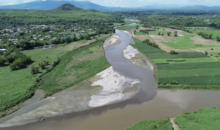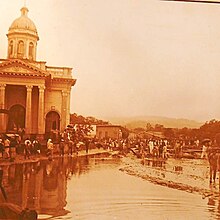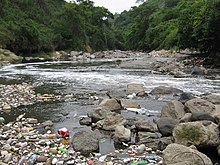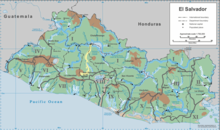Acelhuate River
| Acelhuate River | |
|---|---|
| Río Acelhuate (Spanish) | |
 The Acelhuate River near its mouth as seen from the Carretera Troncal del Norte | |
| Location | El Salvador |
| Coordinates | 14°04′N 89°08′W / 14.067°N 89.133°W[1]: A-1 |
| Type | River |
| Primary outflows | Lempa River |
| Catchment area | 414 square miles (1,070 km2) |
| Max. length | 37 miles (60 km) |
| Settlements | San Salvador |
The Acelhuate River (Spanish: Río Acelhuate) is a river in El Salvador which originates in the San Salvador Department and flows north into the Lempa River and the Cerrón Grande Reservoir. The city of San Salvador was established along the river in the mid-1500s for its clear waters, but it has since become one of El Salvador's most polluted rivers due to improper waste disposal from San Salvador beginning in the mid-1900s. Despite the river's high levels of contamination by domestic and industrial waste, several animal species continue to inhabit the river and around 1.7 million people live in the river's drainage basin.
Etymology
The name "Acelhuate" derives from the Nawat spelling "Axolhuatl". The Nawat name is a combination of the words "axol", a type of flower, and "huatl" meaning "place".[2]
Course

The Acelhuate River originates in western San Salvador Department and flows north through the city of San Salvador, El Salvador's capital city.[1]: A-15 The river runs through the center of the San Salvador Department[1]: A-31 and along part of the northwestern border of the Cuscatlán Department.[1]: A-9 As a part of the Lempa River basin,[1]: A-31 the Acelhuate River ends at the Lempa River (the country's largest river) and the Cerrón Grande Reservoir in north-central El Salvador.[1]: 7 & A-15
The Acelhuate River has a drainage basin of 414 sq mi (1,070 km2), covering 5.1 percent of the country's land area,[3] and is 37 miles (60 km) long.[4]: 23 Several rivers flow into it, including the El Piro, Las Cañas, Sumpa, and Tomayate Rivers.[5]
History

Between 900 and 1200, the Acelhuate River basin was inhabited by the Pipil.[6]: 29 The Pipil abandoned the area around 1200 due to fighting with other Salvadoran indigenous groups.[7]
On 27 September 1546, the Spanish colonial city of San Salvador (originally founded in 1525) was reestablished along the Acelhuate River due to the river and its various tributaries providing the city an abundance of fresh water. At the time, the river's water was clear and suitable to grow crops around.[8][9]: 42–43 In 1576, an oidor (judge) of San Salvador wrote to Spanish king Philip II describing the river's water as "very good and clear and without bad taste" ("muy buena y clara y sin ningún mal sabor"). In 1820, San Salvador council member Mariano Francisco Gómez reported to the Spanish parliament that the city's residents bathed in the river's waters and caught fish, mollusks, pearls, tortoiseshell, and murex.[2]
On 12 June 1922, heavy rains caused the Acelhuate River to overflow in parts of San Salvador and Colón. The floods killed hundreds of people, destroyed buildings, blocked roads, and caused landslides.[10][11][12] During La Matanza, a series of Salvadoran government mass killings in early 1932, the Directorate General of Police executed hundreds communist and Pipil rebels and buried them in mass graves along the Acelhuate River.[13]: 245 & 276 On 3 July 2008, 30 people were killed when a bus fell into the Acelhuate River during a storm; those killed were members of the Misión Cristiana Elim Internacional church.[14]
As of 2018, around 1.7 million people in 19 districts live in the Acelhuate River's drainage basin.[2]
Contamination


The Acelhuate River is one the most contaminated and polluted rivers in El Salvador.[5] The river functions as a drainage for untreated domestic and industrial waste improperly disposed from San Salvador which flows into the Cerrón Grande Reservoir in north-central El Salvador, polluting that body of water in the process.[1]: 5 & 11 A 2015 Salvadoran government survey estimated that domestic waste composed 62 percent of pollutants in the river, industrial waste composed 32 percent, and garbage dumped in the river or caught by rainfall composed the remaining 6 percent.[2][5] Industrial materials such as iron, arsenic, lead, mercury, and zinc are dumped into the river by factories. During El Salvador's dry season (November to April), the river is almost entirely composed of sewage.[2] In 1999, up to 1,600 tons of sewage were dumped into the Acelhuate River every day.[15]
According to Salvadoran government documents, the Acelhuate River began to experience high levels of pollution of contamination during the mid-1900s. A 1979 study of the Acelhuate River conducted by the Ministry of Agriculture and Livestock and the Land Resources Development Center of the Overseas Development Administration of Great Britain described the pollution as "chronic" ("crónica") and as posing a health hazard to people living near the river. The Acelhuate River is one of five rivers labeled by the Ministry of the Environment and Natural Resources as having a water quality bad enough to inhibit the development of aquatic life and pose a danger to humans.[2] El Diario de Hoy's Francisco Rubio and Mauro Arias described the Acelhuate River as a "symbol" ("símbolo") of contamination in El Salvador's rivers.[5]
In a 1998 survey of El Salvador's water resources, the United States Army Corps of Engineers described the river's waters as "severely contaminated" and a "biohazard" and recommended that contact with the river water "should be avoided". The survey also concluded that decontaminating the river through reverse osmosis would not be possible due to high levels of organic chemical compounds in the water. These compounds have contaminated wells and aquifers around the river.[1]: 11 & 12
Decontamination efforts
In June 2015, Minister of the Environment and Natural Resources Lina Pohl introduced a plan to decontaminate the Acelhuate River by 80 percent in 10 years through the construction of four wastewater treatment plants and requiring factories to build treatment plants in their facilities.[16] The government sought to turn the banks of the river into a recreational area once the waters were decontaminated, but the plan was scrapped in 2019 as Pohl stated that the treatment plants were too expensive and that the government had failed to provide adequate funding.[5]
In December 2017, the Hydroelectric Executive Commission of the Lempa River (CEL) began analyzing the possibility of using the Acelhuate River's contaminated water to power a biogas electric power plant.[17] On 20 February 2024, the Legislative Assembly of El Salvador approved funding for CEL to construct such a biogas electric power plant on the Acelhuate River near Ciudad Delgado and Cuscatancingo with the assistance of Saudi Arabian investors.[18] On 9 July, the Legislative Assembly voted to reaffirm the funding, with deputy William Soriano remarking that the project would "solve problems caused in the Acelhuate River" ("solventará problemáticas ocasionadas en el río Acelhuate").[19]
Flora and fauna

Despite the Acelhuate River's contamination, several species of plants and animals continue to inhabit the river and the surrounding areas. The 1979 survey stated that "fish life is non-existent" ("la vida de los peces es inexistente"), but several plant and animal species have since adapted to be able to live in and around the river such as by being able to consume garbage and dead fish.[2]
Several bird species as well as tortoises and some fish inhabit the river. Fishing is possible in some parts of the river, particularly near the mouth of the river where it feeds into the Lempa River and the Cerrón Grande Reservoir.[2] In 2017, non-native crocodiles appeared in the Acelhuate River, which the Ministry of the Environment and Natural Resources believed arrived due to a migration event or due to them being released into the river by a private owner.[20] The axol flower, after which the river is named, can also be found along its banks.[2]
See also
References
- ^ a b c d e f g h i Buckalew, James O.; Knowles, Robert B.; Waite, Laura; James, Maurice; Laprevote, Jim (October 1998). "Water Resources Assessment of El Salvador" (PDF). United States Army Corps of Engineers. Archived from the original (PDF) on 23 August 2017. Retrieved 29 July 2024.
- ^ a b c d e f g h i Meza, Frederick (22 March 2018). "Aún Hay Vida en el Contaminado Acelhuate" [There is Still Life in the Polluted Acelhuate]. La Prensa Gráfica (in Spanish). Retrieved 29 July 2024.
- ^ "Caracterización de la Cuenca Hidrográfica Acelhuate" [Characterization of the Acelhuate Hydrographic Basin]. Central American University (in Spanish). Retrieved 29 July 2024.
- ^ "Actualización del Catastro de Vertidos, Evaluación Sobre la Aplicación, Cumplimiento y Verificación del Marco Técnico y Jurídico de las Aguas Residuales en la Subcuenca del Río Acelhuate" [Update of the Discharge Registry, Evaluation of the Application, Compliance and Verification of the Technical and Legal Framework of Wastewater in the Acelhuate River Sub-Basin] (PDF) (in Spanish). Ministry of the Environment and Natural Resources. February 2011. Retrieved 29 July 2024.
- ^ a b c d e Rubio, Francisco; Arias, Mauro (21 April 2023). "¿Es Posible Rescatar al Río Acelhuate de Su Muerte?" [Is It Possible to Rescue the Acelhuate River from Its Death?]. El Diario de Hoy (in Spanish). Retrieved 29 July 2024.
- ^ Bernal Ramírez, Luis Guillermo & Quijano de Batres, Ana Elia, eds. (2009). Historia 1 El Salvador [History 1 El Salvador] (PDF). Historia El Salvador (in Spanish). El Salvador: Ministry of Education. ISBN 9789992363683. Retrieved 29 July 2024.
- ^ Nunez, Salvador (25 May 2021). "El Salvador: Hidden Truths". Xlibris. ISBN 9781664105348. OCLC 1282933567. Retrieved 29 July 2024.
- ^ Arteaga, Ernesto (1 April 2019). "La Villa de San Salvador fue Fundada un Día Como Hoy Hace 491 Años" [The Villa of San Salvador was Established on a Day Like This 491 Years Ago]. La Prensa Gráfica (in Spanish). Retrieved 29 July 2024.
- ^ Fowler, William R. (4 January 2022). "A Historical Archaeology of Early Spanish Colonial Urbanism in Central America". University Press of Florida. ISBN 9780813057965. OCLC 1257315186. Retrieved 29 July 2024.
- ^ Cañas Dinarte, Carlos; Orellana, Jessica (16 June 2023). "En Imágenes: Así Fue como el Río Acelhuate Destruyó Parte de San Salvador Hace 101 Años" [In Images: This Is How the Acelhuate River Destroyed Parts of San Salvador 101 Years Ago]. El Diario de Hoy (in Spanish). Retrieved 29 July 2024.
- ^ Calderón, Beatriz (2 July 2024). "Así fue la Gran Inundación de San Salvador hace Más de 100 Años, Cuando Existían los "Puentes Portátiles"" [This Was the Great Flood of San Salvador More than 100 Years Ago, When "Portable Bridges" Existed]. La Prensa Gráfica (in Spanish). Retrieved 29 July 2024.
- ^ Cañas Dinarte, Carlos (14 June 2019). "La Lluvia se Volvió Tragedia en San Salvador, en Junio de 1922" [The Rain Turned Into Tragedy in San Salvador, in June 1922]. El Diario de Hoy (in Spanish). Retrieved 29 July 2024.
- ^ Lindo Fuentes, Héctor; Ching, Erik K. & Lara Martínez, Rafael A. (2007). Remembering a Massacre in El Salvador: The Insurrection of 1932, Roque Dalton, and the Politics of Historical Memory. Albuquerque, New Mexico: University of New Mexico Press. ISBN 9780826336040. OCLC 122424174. Retrieved 29 July 2024.
- ^ "Sube a 30 Cifra de Muertos en Autobús Arrastrado por un Río en San Salvador". La Prensa (in Spanish). 4 July 2008. Retrieved 29 July 2024.
- ^ Kovaleski, Serge F. (17 March 1999). "Salvador's River of Poison". The Washington Post. San Salvador, El Salvador. Retrieved 29 July 2024.
- ^ "El Salvador Revela Plan para Descontaminar Río Acelhuate" [El Salvador Reveals Plan to Decontaminate the Acelhuate River]. BNamericas (in Spanish). 8 June 2015. Retrieved 29 July 2024.
- ^ Orellana, Javier (7 December 2017). "Analizan Darle Este Uso al Agua del Acelhuate" [They Analyze Giving This Use to Acelhuate's Water]. La Prensa Gráfica (in Spanish). Retrieved 29 July 2024.
- ^ "Diputados Aprueban Fondos para Construir Generadora de Electricidad a Base de Biogás" [Deputies Approve Funds to Construct a Electricity Generator with a Biogas Base]. Diario1 (in Spanish). 20 February 2024. Retrieved 29 July 2024.
- ^ Crespín, Verónica (9 July 2024). "Crédito para Planta de Biogás en el Río Acelhuate Recibe Segunda Votación" [Credit for a Biogas Plant on the Acelhuate River Receives a Second Vote]. El Mundo (in Spanish). Retrieved 29 July 2024.
- ^ "¿Cómo Llegaron los Cocodrilos al Acelhuate? Estas son las Hipótesis del MARN" [How Did Crocodiles Arrive to Acelhuate? These are MARN's Hypotheses]. La Prensa Gráfica (in Spanish). 18 January 2017. Retrieved 29 July 2024.
Further reading
- Arteaga, Ernesto (12 February 2019). "Video: La Impactante Unión Donde las Negras Aguas del Acelhuate se Mezclan con el Río Lempa" [Video: The Impactful Union Where the Black Waters of Acelhuate Mix with the Lempa River]. La Prensa Gráfica (in Spanish). Retrieved 29 July 2024.
- Baires Quezada, Rodrigo (14 June 2010). "Buscarse la Vida Entre las Cloacas" [Finding Life Among the Sewers]. El Faro (in Spanish). Retrieved 29 July 2024.
- "Evaluación del Grado de Contaminación del Río Acelhuate" [Evaluation of the Level of Contamination of the Acelhuate River] (PDF). National Service of Territorial Studies (in Spanish). April 2005. Retrieved 30 July 2024.
- Govines, Alessia (30 April 2021). "Río Acelhuate: Detallan Consorcio FICHTNER/EC para Limpiar y Generar Electricidad" [Acelhuate River: FICHTNER/EC Consortium to Clean and Generate Electricity Details]. Contra Punto (in Spanish). Retrieved 29 July 2024.
- Peña, Víctor; Martínez, Carlos (2 June 2020). "El Río Acelhuate Saqueó la Comunidad El Granjero II" [The Acelhuate River Pillaged the El Granjero II Community]. El Faro (in Spanish). Retrieved 29 July 2024.
External links
- "Contaminación en el Río Acelhuate y Planes para su Revitalización" [Contamination in the Acelhuate River and Plans for Its Revitalization]. YouTube (in Spanish). Channel 12. 2 April 2024. Retrieved 30 July 2024.
- "En el Día del Agua... Hay Vida en el Acelhuate" [In the Day of Water... There is Life in the Acelhuate]. YouTube (in Spanish). La Prensa Gráfica. 22 March 2018. Retrieved 30 July 2024.
